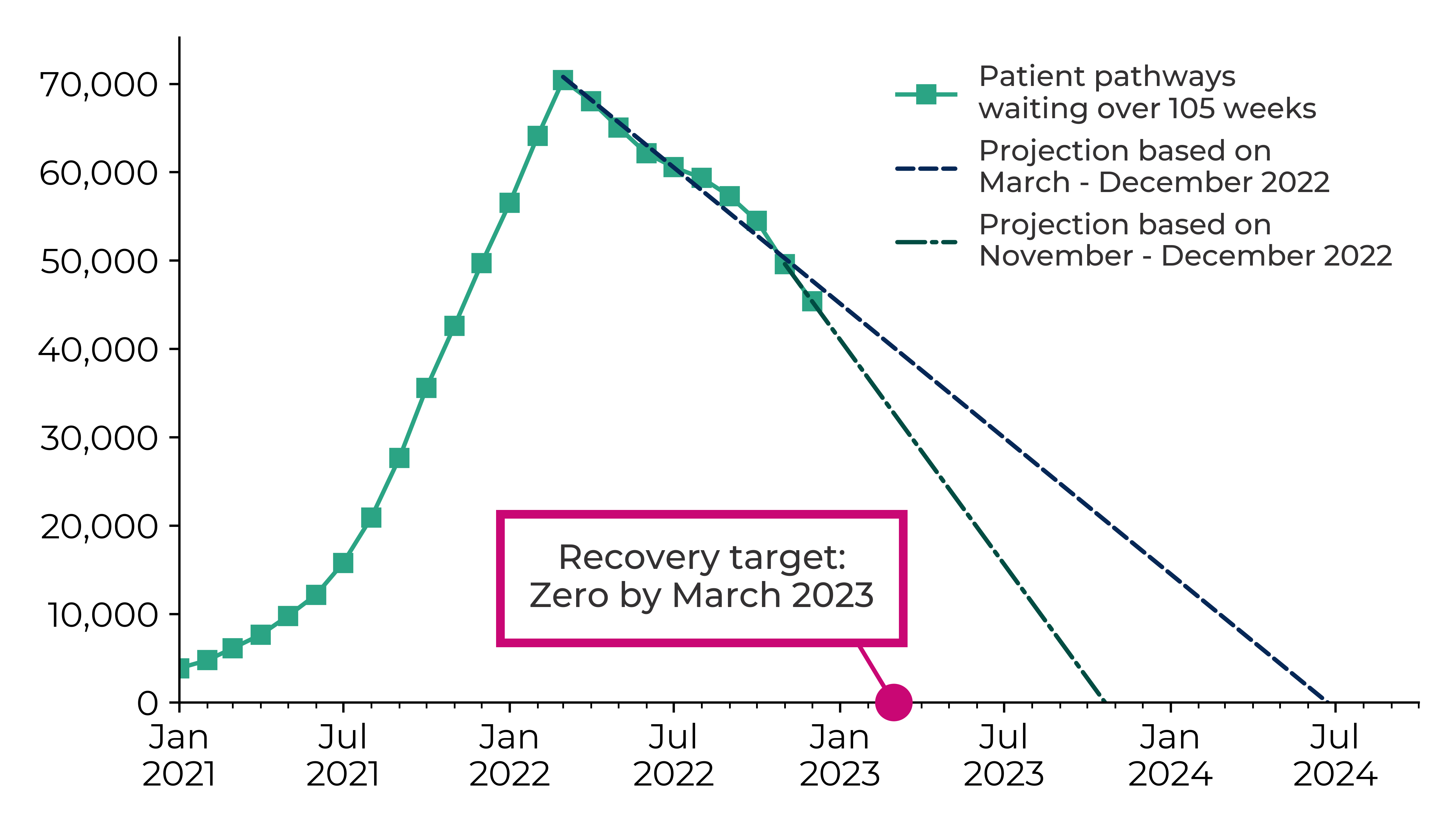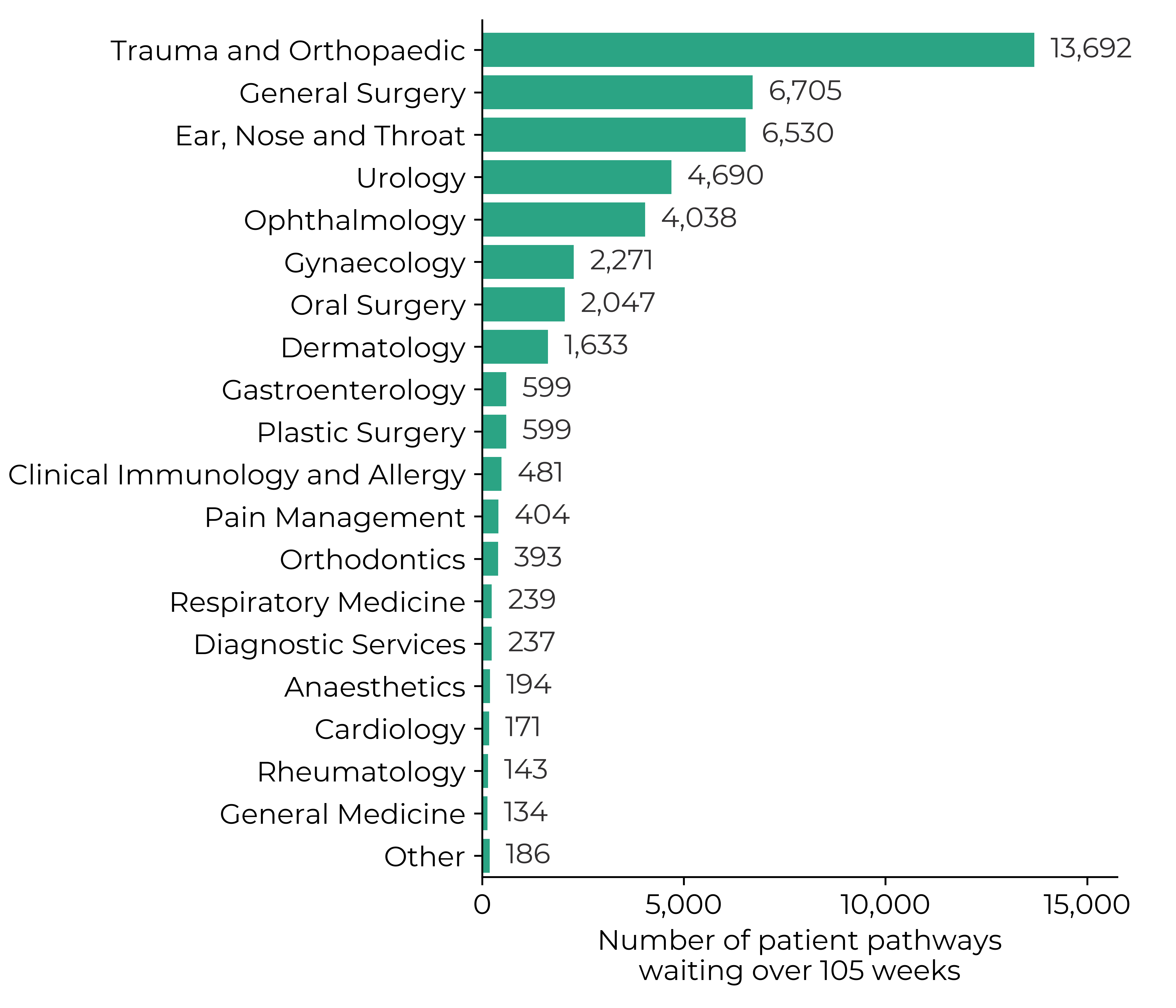Waiting lists in Wales now stand at 735,000 open patient pathways (December 2022 figures). That equates to around 577,400 individual patients on treatment waiting lists (because some people have multiple open pathways).
The number of people waiting for NHS treatment has reached record levels. The number of patient pathways (i.e. the route a patient follows from their first referral through to the start of treatment) at the end of December 2022 was 59% higher than February 2020. The average (median) wait time for treatment is 22 weeks (December 2022). That’s more than double what it was before the COVID-19 pandemic (when the average waiting time was around 10 weeks).
When the Welsh Government published its programme for transforming and modernising planned care and reducing waiting lists in Wales last year, it committed to five recovery targets (i.e. new waiting times targets/ previously referred to as ambitions). Data on performance against these recovery targets is published monthly on the StatsWales website (with a two month lag).
- No one waiting longer than a year for their first outpatient appointment by the end of 2022.
- Eliminate the number of people waiting longer than two years in most specialities by March 2023.
- Increase the speed of diagnostic testing and reporting to eight weeks and 14 weeks for therapy interventions by Spring 2024.
- Eliminate the number of people waiting longer than one year in most specialities by Spring 2025.
- Cancer diagnosis and treatment to be undertaken within 62 days for 80% of people by 2026.
Some commentators warn against solely focusing on meeting targets. The Wales Centre for Public Policy says it risks “inducing unintended consequences” because it can distort behaviours. Targets don’t always lead to improvements in the quality of service. Whilst this is true, the recovery targets indicate whether policies intended to improve waiting times are effective and/or are being implemented quickly enough.
We regularly update our article ‘Reducing the NHS waiting list backlog’, which sets out performance against the five recovery targets. This article draws on NHS Wales activity data to consider progress against the first two recovery targets. We also provide a link to local data on NHS waiting times.
Further information on the recovery targets is provided in the Senedd’s Health and Social Care Committee’s NHS waiting times monitoring report.
First recovery target missed
The first recovery target says patients shouldn’t be waiting longer than a year for their first outpatient appointment. The Welsh Government said it would achieve this by the end of 2022.
Despite a recent increase in activity, the target has been missed. Progress in clearing the backlog has been slower than expected. At the end of December 2022, there were still 74,976 patient pathways waiting over 53 weeks (more than a year) for their first outpatient appointment. The number hasn’t been below 75,000 since January 2021.
We are also yet to see the full impact of winter pressures and industrial action on waiting times.
Figure 1: Number of patient pathways waiting over 53 weeks for their first outpatient appointment

Source: StatsWales, Patient pathways waiting to start treatment by month, grouped weeks and stage of pathway
Second recovery target fast approaching
The second recovery target is to clear the backlog of people waiting longer than two years to start treatment. The Welsh Government say it will achieve this in most specialties by March 2023.
In December 2022, 45,386 patient pathways were waiting over 105 weeks (more than two years) to start treatment across all specialties.
Figure 2 below shows the number of patient pathways waiting over 105 weeks has decreased since March 2022. The December 2022 data shows 9 consecutive monthly falls after a consistent increase over the previous year.
However, a projection using data from March to November shows that, at the current rate of progress (i.e. the rate of progress since March is sustained), the recovery target will not be fulfilled until the middle of 2024.
There was a sharper drop in patient pathways between November and December 2022. Sustaining this rate of progress would meet the target by the latter half of 2023.
Fulfilling the recovery target by March 2023 requires faster progress.
Figure 2: Number of patient pathways waiting over 105 weeks to start treatment and projections based on different time periods

Source: StatsWales, COVID-19 recovery plan, ambitions for referral to treatment waiting times
The December data shows that 30% of all patient pathways waiting over 105 weeks to start treatment were waiting for trauma and orthopaedic treatments.
Other specialities with high numbers waiting over 105 weeks for treatment include; general surgery (6,705 patient pathways), ear, nose and throat treatments (6,530) and urology (4,690).
Figure 3: Number of patient pathways waiting over 105 weeks to start treatment by treatment function

Source: StatsWales, Patient pathways waiting to start treatment by month, grouped weeks and treatment function, January 2021 onwards
While the number of patient pathways waiting for treatment remains stubbornly high in these specialties, progress is being made, with the overall numbers waiting decreasing.
No ‘silver bullet’
The pressures facing NHS Wales are well documented. Achieving the recovery targets quickly requires activity on a scale not seen before.
NHS activity has increased. New ways of managing waiting times have been introduced. There are examples of innovation in clinical and operational practice. There is clear political focus – the Health Minister, Eluned Morgan MS has made planned care and recovery a Ministerial priority. But substantial reductions in waiting times are still to be achieved.
Has the Health Minister got the balance right in both challenging and supporting local NHS organisations to improve their performance? Or is the scale of the challenge insurmountable (i.e. demand for health care and the availability of resources to meet that demand) and the effort required to reduce waiting times already spent?
While individual policy initiatives are making a difference, addressing long waits requires transformation. At the current rate of progress, it seems likely that tackling NHS waiting times will take longer than “a full Senedd term” (previously stated by the Welsh Government) – and a lot more hard work.
The Senedd’s Health and Social Care Committee’s Waiting times report, called on the Welsh Government to publish more granular data on NHS waiting times, so that patients across Wales could have a more realistic view of how long they’re likely to wait for NHS treatment.
The Welsh Government has been working with the 111 national website to publish data by speciality and health board.
Article by Sarah Hatherley, Joe Wilkes and Helen Jones, Senedd Research, Welsh Parliament






